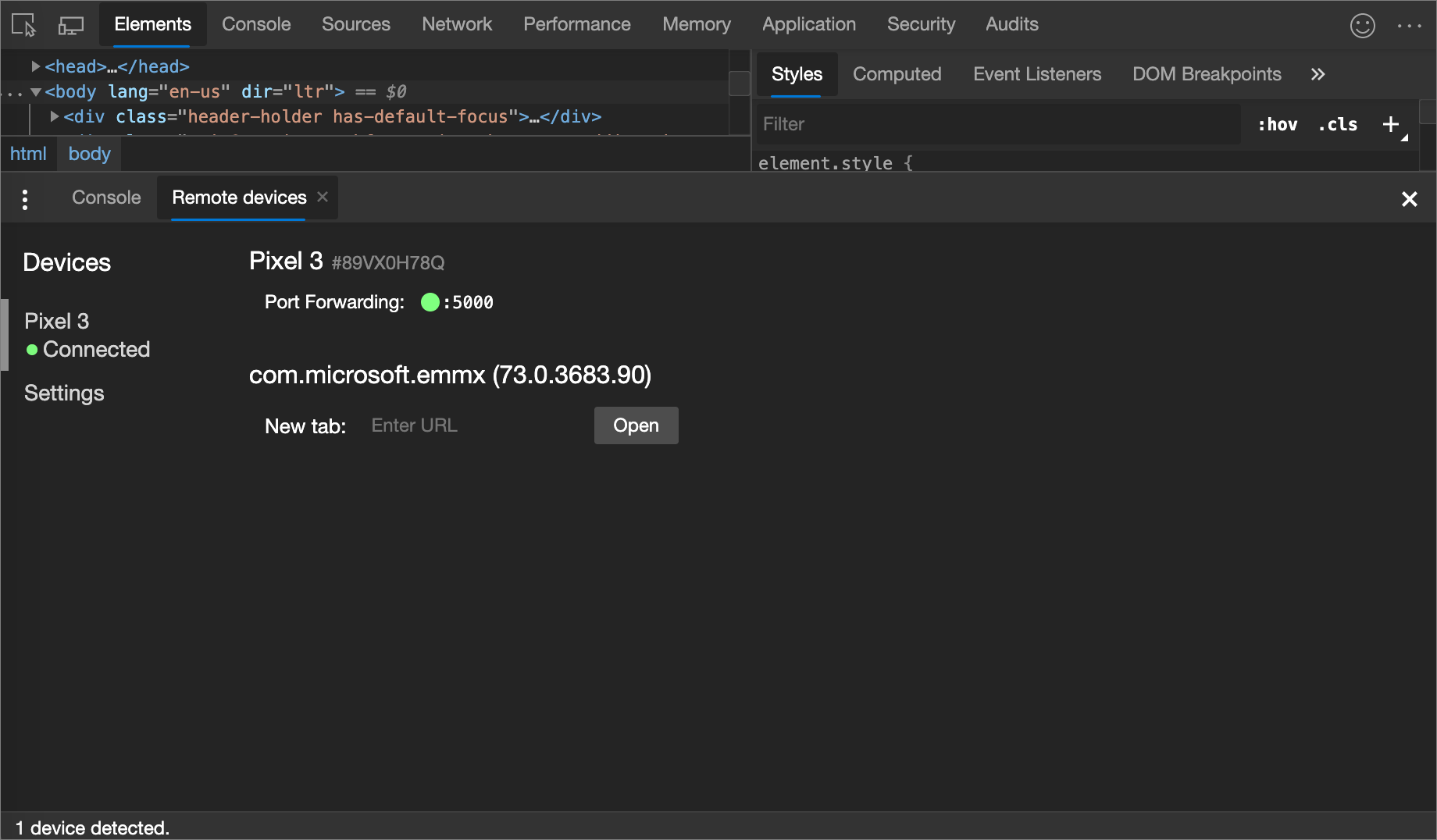Note
Access to this page requires authorization. You can try signing in or changing directories.
Access to this page requires authorization. You can try changing directories.
Host a site on a development machine web server, then access the content from an Android device.
Port forwarding enables you to view content hosted by the web server running in your development machine on your Android device.
If your web server is using a custom domain, set up your Android device to access the content at that domain with custom domain mapping.
With a USB cable and Microsoft Edge DevTools, run a site from a development machine and then view the site on an Android device.
Set up port forwarding
Port forwarding enables your Android device to access content that is being hosted on the web server running in your development machine. Port forwarding works by creating a listening TCP port on your Android device that maps to a TCP port on your development machine.
Traffic between the ports travel through the USB connection between your Android device and development machine, so the connection doesn't depend on your network configuration.
To enable port forwarding:
Set up remote debugging between your development machine and your Android device. When you are finished, your Android device should be displayed in the left-hand menu of the Inspect Devices dialog and a Connected status indicator.
In the Inspect Devices dialog in DevTools, enable Port forwarding.
Click Add rule.

In the Device port text box on the left, enter the
localhostport number from which you want to be able to access the site on your Android device. For example, if you wanted to access the site fromlocalhost:5000enter5000.In the Local address text box on the right, enter the IP address or hostname on which your site is hosted on the web server running in your development machine, followed by the port number. For example, if your site is running on
localhost:7331enterlocalhost:7331.Click Add.
Port forwarding is now set up.
You can see the status indicator for the port forward at the top, as well as beside the device name. The indicator for the port forward is on the tab on your device within the Inspect Devices dialog.

To view the content, open up Microsoft Edge on your Android device and go to the localhost port that you specified in the Device port field. For example, if you entered 5000 in the field, visit localhost:5000.
Map to custom local domains
Custom domain mapping enables you to view content on an Android device from a web server on your development machine that is using a custom domain.
For example, suppose that your site uses a third-party JavaScript library that only works on the domain microsoft-edge.devtools. So, you create an entry in your hosts file on your development machine to map this domain to localhost (for example, 127.0.0.1 microsoft-edge.devtools). After setting up custom domain mapping and port forwarding, view the site on your Android device at the URL microsoft-edge.devtools.
Set up port forwarding to proxy server
To map a custom domain you must run a proxy server on your development machine. Examples of proxy servers are Charles, Squid, and Fiddler.
To set up port forwarding to a proxy:
Run the proxy server and record the port that it is using.
Note
The proxy server and your web server must run on different ports.
Set up port forwarding to your Android device. For the local address field, enter
localhost:followed by the port that your proxy server is running on. For example, if it is running on port8000, go tolocalhost:8000. In the device port field enter the number that you want your Android device to listen on, such as3333.
Configure proxy settings on your device
Next, you need to configure your Android device to communicate with the proxy server.
On your Android device, navigate to Settings > Wi-Fi.
Long-press the name of the network to which you are currently connected.
Note
Proxy settings apply per network.
Click Modify network.
Click Advanced options. The proxy settings display.
Click the Proxy menu and then select Manual.
For the Proxy hostname field, enter
localhost.For the Proxy port field, enter the port number that you entered for device port in the previous section.
Click Save.
With these settings, your device forwards all of its requests to the proxy on your development machine. The proxy makes requests on behalf of your device, so requests to your customized local domain are properly resolved.
Now access custom domains on your Android device just like on the development machine.
If your web server is running off of a non-standard port, remember to specify the port when requesting the content from your Android device. For example, if your web server is using the custom domain microsoft-edge.devtools on port 7331, when you view the site from your Android device you should be using the URL microsoft-edge.devtools:7331.
Tip
To resume normal browsing, remember to revert the proxy settings on your Android device after you disconnect from the development machine.
Note
Portions of this page are modifications based on work created and shared by Google and used according to terms described in the Creative Commons Attribution 4.0 International License. The original page is found here and is authored by Kayce Basques and Meggin Kearney.
 This work is licensed under a Creative Commons Attribution 4.0 International License.
This work is licensed under a Creative Commons Attribution 4.0 International License.